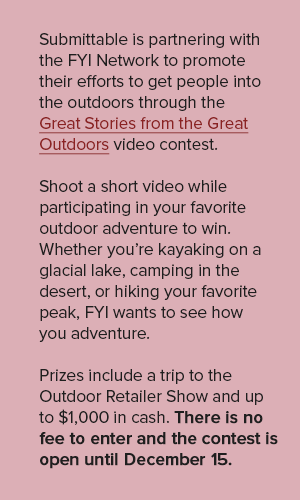There’s nothing like a rugged adventure in the great outdoors. People that are passionate about exploring the wild are often passionate about sharing their stories through a lens. Submittable has partnered with the FYI Network to collect stories of this kind. To help you make the most of your time in the outdoors while staying safe, we turned to Missoula-based photographer, Brian Christianson, for some expert tips on adventure videography and photography.
1. Prioritize the camera equipment you pack.
Prioritizing space can be one of the trickiest aspects of preparing for an outdoor adventure, especially if you’re bringing camera equipment. Without sacrificing your survival essentials, packing enough batteries, lenses, and camera bodies can be a struggle.
Even experienced photographers like Brian struggle with this dilemma. “In terms of lenses, I always try to bring an 11-24 mm, 24-70 mm, and a 70-200 mm. If space is an issue though, I leave the 70-200 mm behind.” As a landscape photographer, Brian’s telephoto lenses, like the 70-200 mm, are not as essential as his wide-angle lens. He also brings a polarizer, neutral density and graduated neutral density filters, and a microfiber cloth to protect his equipment.
2. Look for light, not subjects.
Every photographer or videographer has another that they look up to and admire. For Brian, that person is Galen Rowell. “What I appreciate about his philosophy is he was a mountaineer first and then started bringing a camera with him. He went from professional climbing to professional photography. And he started writing books about it. His books are philosophy-driven about outdoor photography. He talks a lot about how to see the landscape, how to look differently at the landscape. Even though he shot a while ago, it still holds up.”
One particular part of Rowell’s philosophy that has had a big impact on Brian’s photography is how he looks at light. “He first talked about how important observing the scene is in terms of light. When it compliments a subject or landscape, that’s when it all comes together. It’s about being more open minded when you have a subject. Look at the light and shoot with that in mind. Thinking about light in that way was transformative for me.”
3. Pack your outdoor essentials first and foremost.
While you might not get the video or photos you need if you forget certain camera equipment, nothing will ruin a trip into the outdoors more than forgetting essential survival gear, especially when backpacking in the winter. Survival essentials like fire, water, appropriate attire, and shelter can make or break a trip into the wilderness.
“In the winter I never leave without a fire-starter, just in case fuel runs out and lighters run out, since making fire is critical,” says Brian.
Warmth, says Brian, is a key component to keep in mind when packing for a trek. “I always bring one more pair of socks than days I will out. I always have a set of emergency hand and foot warmers. While I don’t always use them, I’d rather have them than not. It’s a sense of security knowing you have them.”
4. In cold temperatures, be aware of condensation.
“[Condensation] happens with a rapid change in temperature. For instance if you’re shooting at your house and you walk outside in the cold [with your camera] and then immediately walk back inside, where it’s warm, condensation can occur.”
Condensation can destroy electronics of all kinds, but when shooting in cold weather, it’s especially important to keep in mind to take extra care of your camera.
Brian’s advice? “I leave my camera in my backpack on trips and when I bring it into my house after, I leave it in the cool backpack so it can warm up to room temperature slowly, preventing serious condensation.”
5. Educate yourself.
Of course, Brian didn’t just start wandering into the wilderness with a camera and gear but no training. Any safety-conscious and experienced outdoor enthusiast will tell you the risks of any outdoor adventure are greatly reduced with proper training and education. Many Western mountain states like Utah and Colorado have designated avalanche education centers, aimed at teaching skiers and snowboarders how to avoid sometimes fatal accidents in the backcountry.
While briefly living in Colorado, Brian took several outdoor education classes to better prepare himself for backcountry adventures. “I learned first how to backpack safely, then winter mountaineering and how to do that safely, and then backcountry snowboarding.” So far this education has served him well and kept him prepared for whatever could come his way in the wilderness.
While adventure videography and photography may seem intimidating to many people, the great thing is there is no one way to do it. Brian is particularly interested in winter backpacking and backcountry snowboarding, but many people take their cameras climbing, kayaking, canoeing, biking, and more. Whatever outdoor adventure you choose, grab your camera, pack your survival gear, and go chase the light in your favorite outdoor setting.
This article is a sponsored post for the FYI Network. FYI is partnering with Submittable to find Great Stories from the Great Outdoors. Interested in more creative calls and opportunities? Sign up for our creative opportunities email.

